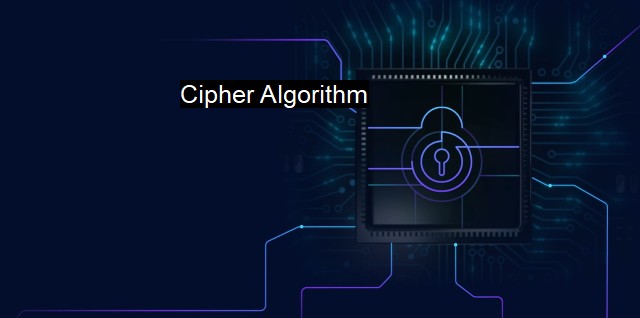What is Cipher Algorithm?
Cipher Algorithms in Cybersecurity: Securing Digital Data with Key-based Encryption Techniques
A cipher algorithm, also known as an encryption algorithm, is a set of defined steps used to encrypt or decrypt information. In the context of cybersecurity and antivirus programs, cipher algorithms play a crucial role in preserving the integrity, confidentiality, and availability of data and information systems.The concept of a cipher algorithm is deeply associated with the broader field of cryptography. Cryptography, derived from the Greek words "cryptos," meaning secret, and "graphein," which stands for writing, is the practice of securing data and information by converting plain text into an unintelligible form known as ciphertext. This secure way of protecting information often takes place with the use of an encryption key, an essential component in the process of transforming text into encrypted information.
A cipher algorithm acts as a guide to this conversion process and is often complex. The algorithm, working together with the encryption key, transforms the plain data into an encrypted form, making it indistinguishable even if intercepted during a cyber attack. This protection prevents cybercriminals from reading and interpreting sensitive information, playing a vital role in securing digital communication channels, online transactions, and personal data stored or transferred over the Internet.
Two primary types of cipher algorithms are used in cybersecurity: symmetric and asymmetric algorithms. Symmetric encryption, which includes algorithms like DES (Data Encryption Standard) and AES (Advanced Encryption Standard), uses the same encryption key for both encrypting and decrypting the data. While the symmetric algorithm provides speed and simplicity, it has a significant downside. Passing the encryption key between two parties securely can be challenging. If this key is compromised, the encrypted data it protects become instantly vulnerable and easily decipherable.
On the other hand, asymmetric encryption or public-key encryption, uses two distinct keys - a public key used for encrypting data and a private key for decryption. Algorithms like RSA (Rivest–Shamir–Adleman) and ECC (Elliptic Curve Cryptography) fall within this category. Its significant advantage is that the public key can be freely distributed, while the private key can remain entirely confidential. This process not only facilitates the safe transmission of data but also verifies authenticity through digital signatures.
Cipher algorithms are vital components in antivirus software as well. Antivirus software uses these algorithms to scan and decrypt malicious encrypted codes embedded by hackers in networks or files. Unseen by regular users, this process is continually running in the background, ensuring the safety and integrity of data and systems.
With evolving technology, the challenge remains for cryptographic algorithms to stay ahead of potential threats. Quantum computers pose one such danger, as they could crack current cryptographic algorithms with higher speed and efficiency. In response, the world of cybersecurity is delving into post-quantum cryptography, aiming to develop new algorithms resistant to quantum attacks.
a cipher or encryption algorithm is an indispensable tool in the world of cybersecurity and antivirus protection. A continual cryptographic race exists between progressing technology and potential threats. Sophisticified encryption algorithms ensure secure digital communication channels, data security, and personal privacy, forming a solid barrier against unauthorized access and cyber attacks.

Cipher Algorithm FAQs
What is a cipher algorithm?
A cipher algorithm is a set of rules or procedures that are used to encode or decode information. It is a method of transforming plain text into coded text to ensure the confidentiality and integrity of data. In cybersecurity, cipher algorithms are widely used to secure sensitive data by encrypting it before transmission.How does a cipher algorithm work?
A cipher algorithm works by taking a plaintext message and transforming it into a ciphertext message. This transformation is done using a secret key, which is a string of characters that determines the specific transformation used. The resulting ciphertext can only be read by someone who has the key to decrypt it back into plaintext. The strength of the algorithm lies in the complexity of the transformation and the length of the key used.What is the difference between symmetric and asymmetric cipher algorithms?
Symmetric cipher algorithms use a single key for both encryption and decryption of data, while asymmetric cipher algorithms use two keys - one for encryption and one for decryption. In symmetric algorithms, the same key is used by both parties to encrypt and decrypt the message, while in asymmetric algorithms, the public key is used for encryption and the private key is used for decryption. Asymmetric algorithms are considered more secure but are computationally more expensive than symmetric algorithms.How do antivirus programs use cipher algorithms?
Antivirus programs use cipher algorithms to encrypt and decrypt the information exchanged between the program and its servers. This is done to ensure the confidentiality and integrity of the data transmitted. Cipher algorithms are also used to encode the virus signature database, making it difficult for hackers to decipher or manipulate the signatures. By using strong cipher algorithms, antivirus programs can effectively protect users against cyber threats.| | A | | | B | | | C | | | D | | | E | | | F | | | G | | | H | | | I | | | J | | | K | | | L | | | M | |
| | N | | | O | | | P | | | Q | | | R | | | S | | | T | | | U | | | V | | | W | | | X | | | Y | | | Z | |
| | 1 | | | 2 | | | 3 | | | 4 | | | 7 | | | 8 | | |||||||